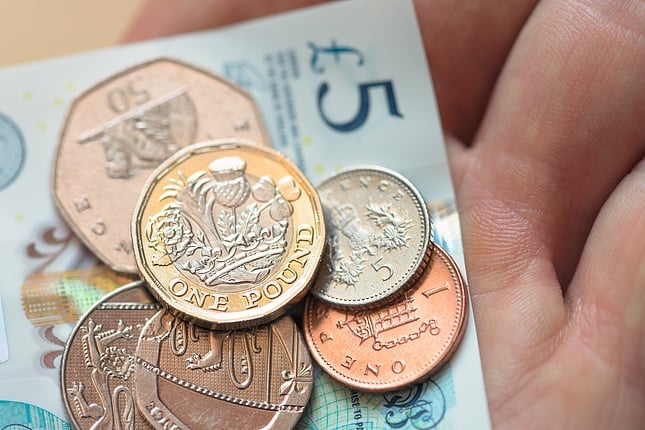- The Japanese Yen loses traction following an early uptick against the US Dollar (USD) on Friday
- The divergent Fed-BoJ policy expectations keep a lid on any further upside for the USD/JPY pair.
- Traders now look to the US ISM PMI for short-term impetus ahead of Fed Chair Powell’s speech.
The Japanese Yen (JPY) struggles to preserve its modest intraday gains against the US Dollar (USD) on Friday in the wake of the recent less-hawkish remarks by Bank of Japan (BoJ) officials. In fact, BoJ board member Seiji Adachi, along with Toyoaki Nakamura, downplayed speculations that the central bank will pull out of ultra-loose monetary policy settings and end negative interest rates as early as January 2024. This, in turn, undermines the JPY and assists the USD/JPY pair to rebound over 50 pips from the daily low.
Spot prices hold steady above the 148.00 mark through the early European session, albeit lack follow-through amid subdued USD demand. Investors are convinced that the Federal Reserve (Fed) is done raising interest rates and could begin easing its policy by the first half of next year. The bets were lifted by Thursday's US macro data, which indicated a further moderation in inflationary pressures and a slowing labor market. This fails to assist the USD to build on its recovery from a multi-month low and caps the USD/JPY pair.
Apart from this, mixed economic signals from China, amid a darkening global outlook, benefit the JPY's relative safe-haven status and keep a lid on any meaningful upside for the USD/JPY pair. Furthermore, traders prefer to wait for Fed Chair Jerome Powell's speech for fresh cues about interest rates and some meaningful impetus. Heading into the key event risk, the release of the US ISM Manufacturing PMI could influence the USD price dynamics and allow traders to grab short-term opportunities on the last day of the week.
Daily Digest Market Movers: Japanese Yen remains on track to register gains for the third straight week against USD
- Bank of Japan board member Seiji Adachi said on Wednesday that it was premature to debate an exit from negative interest rates as the country is yet to see a positive wage-inflation cycle become embedded enough.
- A fellow board member Toyoaki Nakamura noted on Thursday that now is not the time to consider shifting policy and that the BoJ must be cautious about phasing out its massive stimulus measures.
- Investors, meanwhile, expect that the substantial pay increases witnessed this year – the largest in over 30 years – will continue into 2024 and should allow the BoJ to pivot away from its dovish stance.
- Macro data released earlier this Friday showed that Japan's unemployment rate unexpectedly ticked down to 2.5% in October from 2.6% in the previous month, though does little to influence the Japanese Yen.
- The final Japan au Jibun Bank Manufacturing PMI showed that business activity shrank at the fastest pace in nine months and fell to 48.3 in November from 48.7 in the previous month.
- The US Commerce Department reported on Thursday that inflation – as measured by the Personal Consumption Expenditures (PCE) Price Index – was unchanged in October as compared to 0.4% in September.
- Over the 12 months through October, the PCE Price Index decelerated from 3.4% to 3.0%, registering the smallest year-on-year increase since March 2021.
- The core PCE, which strips out volatile food and energy prices, rose by a modest 0.2% in October and saw an annual rise of 3.5%, matching expectations and pointing to signs of easing inflation.
- The number of Americans who applied for unemployment benefits rose by 7K to 218K during the week ended on November 25 and Continuing Claims surged to a two-year high.
- New York Fed Bank President John Williams said that the central bank's policy stance is the most restrictive in 25 years, and it will probably need to stay restrictive for quite some time.
- San Francisco Fed President Mary Daly struck a similar tone and noted that her base case does not call for any further rate hikes, though it was too early to know if the Fed is finished with the rate increases.
- The USD, however, struggles to attract any follow-through buying amid growing market conviction that the Fed may start easing its monetary policy as early as March 2024.
- Market participants now look forward to Fed Chair Jerome Powell's scheduled speeches later during the US session for short-term trading opportunities on the last day of the week.
Technical Analysis: USD/JPY bulls needs to wait for a move beyond overnight swing high around mid-148.00s
From a technical perspective, weakness below the Asian session low, around the 147.60 area, might continue to find some support near the 100-day Simple Moving Average (SMA), currently around the 147.15 area. This is followed by the 147.00 mark, below which the USD/JPY pair could slide back to the 146.65 region, or its lowest level since September 12 touched on Wednesday. Some follow-through selling could expose the 146.00 round figure before spot prices extend the downfall further towards the next relevant support near the mid-145.00s.
On the flip side, any subsequent move up is likely to confront a stiff resistance near the overnight swing high, around the 148.50 region. A sustained strength beyond the latter might trigger a short-covering rally and allow the USD/JPY pair to reclaim the 149.00 mark. The momentum could get extended further towards the 149.55-149.60 supply zone. The latter should act as a key pivotal point, which if cleared will suggest that spot prices have formed a near-term bottom.
Japanese Yen price in the last 30 days
The table below shows the percentage change of Japanese Yen (JPY) against listed major currencies in the last 30 days. Japanese Yen was the weakest against the New Zealand Dollar.
| USD | EUR | GBP | CAD | AUD | JPY | NZD | CHF | |
| USD | -3.12% | -4.14% | -2.50% | -4.52% | -2.42% | -6.55% | -4.09% | |
| EUR | 3.02% | -1.00% | 0.62% | -1.38% | 0.66% | -3.35% | -0.95% | |
| GBP | 3.98% | 0.98% | 1.60% | -0.38% | 1.63% | -2.33% | 0.06% | |
| CAD | 2.43% | -0.62% | -1.61% | -1.99% | 0.07% | -3.96% | -1.56% | |
| AUD | 4.34% | 1.36% | 0.39% | 1.95% | 2.01% | -1.93% | 0.42% | |
| JPY | 2.35% | -0.68% | -1.68% | -0.06% | -2.09% | -4.08% | -1.59% | |
| NZD | 6.15% | 3.27% | 2.28% | 3.87% | 1.91% | 3.88% | 2.34% | |
| CHF | 3.93% | 0.93% | -0.06% | 1.53% | -0.42% | 1.58% | -2.41% |
The heat map shows percentage changes of major currencies against each other. The base currency is picked from the left column, while the quote currency is picked from the top row. For example, if you pick the Euro from the left column and move along the horizontal line to the Japanese Yen, the percentage change displayed in the box will represent EUR (base)/JPY (quote).
Fed FAQs
What does the Federal Reserve do, how does it impact the US Dollar?
Monetary policy in the US is shaped by the Federal Reserve (Fed). The Fed has two mandates: to achieve price stability and foster full employment. Its primary tool to achieve these goals is by adjusting interest rates.
When prices are rising too quickly and inflation is above the Fed’s 2% target, it raises interest rates, increasing borrowing costs throughout the economy. This results in a stronger US Dollar (USD) as it makes the US a more attractive place for international investors to park their money.
When inflation falls below 2% or the Unemployment Rate is too high, the Fed may lower interest rates to encourage borrowing, which weighs on the Greenback.
How often does the Fed hold monetary policy meetings?
The Federal Reserve (Fed) holds eight policy meetings a year, where the Federal Open Market Committee (FOMC) assesses economic conditions and makes monetary policy decisions.
The FOMC is attended by twelve Fed officials – the seven members of the Board of Governors, the president of the Federal Reserve Bank of New York, and four of the remaining eleven regional Reserve Bank presidents, who serve one-year terms on a rotating basis.
What is Quantitative Easing (QE) and how does it impact USD?
In extreme situations, the Federal Reserve may resort to a policy named Quantitative Easing (QE). QE is the process by which the Fed substantially increases the flow of credit in a stuck financial system.
It is a non-standard policy measure used during crises or when inflation is extremely low. It was the Fed’s weapon of choice during the Great Financial Crisis in 2008. It involves the Fed printing more Dollars and using them to buy high grade bonds from financial institutions. QE usually weakens the US Dollar.
What is Quantitative Tightening (QT) and how does it impact the US Dollar?
Quantitative tightening (QT) is the reverse process of QE, whereby the Federal Reserve stops buying bonds from financial institutions and does not reinvest the principal from the bonds it holds maturing, to purchase new bonds. It is usually positive for the value of the US Dollar.
Information on these pages contains forward-looking statements that involve risks and uncertainties. Markets and instruments profiled on this page are for informational purposes only and should not in any way come across as a recommendation to buy or sell in these assets. You should do your own thorough research before making any investment decisions. FXStreet does not in any way guarantee that this information is free from mistakes, errors, or material misstatements. It also does not guarantee that this information is of a timely nature. Investing in Open Markets involves a great deal of risk, including the loss of all or a portion of your investment, as well as emotional distress. All risks, losses and costs associated with investing, including total loss of principal, are your responsibility. The views and opinions expressed in this article are those of the authors and do not necessarily reflect the official policy or position of FXStreet nor its advertisers. The author will not be held responsible for information that is found at the end of links posted on this page.
If not otherwise explicitly mentioned in the body of the article, at the time of writing, the author has no position in any stock mentioned in this article and no business relationship with any company mentioned. The author has not received compensation for writing this article, other than from FXStreet.
FXStreet and the author do not provide personalized recommendations. The author makes no representations as to the accuracy, completeness, or suitability of this information. FXStreet and the author will not be liable for any errors, omissions or any losses, injuries or damages arising from this information and its display or use. Errors and omissions excepted.
The author and FXStreet are not registered investment advisors and nothing in this article is intended to be investment advice.
Recommended content
Editors’ Picks

EUR/USD holds on to intraday gains after upbeat US data
EUR/USD remains in positive ground on Friday, as profit-taking hit the US Dollar ahead of the weekend. Still, Powell's hawkish shift and upbeat United States data keeps the Greenback on the bullish path.

GBP/USD pressured near weekly lows
GBP/USD failed to retain UK data-inspired gains and trades near its weekly low of 1.2629 heading into the weekend. The US Dollar resumes its advance after correcting extreme overbought conditions against major rivals.

Gold stabilizes after bouncing off 100-day moving average
Gold trades little changed on Friday, holding steady in the $2,560s after making a slight recovery from the two-month lows reached on the previous day. A stronger US Dollar continues to put pressure on Gold since it is mainly priced and traded in the US currency.

Bitcoin to 100k or pullback to 78k?
Bitcoin and Ethereum showed a modest recovery on Friday following Thursday's downturn, yet momentum indicators suggest continuing the decline as signs of bull exhaustion emerge. Ripple is approaching a key resistance level, with a potential rejection likely leading to a decline ahead.

Week ahead: Preliminary November PMIs to catch the market’s attention
With the dust from the US elections slowly settling down, the week is about to reach its end and we have a look at what next week’s calendar has in store for the markets. On the monetary front, a number of policymakers from various central banks are scheduled to speak.

Best Forex Brokers with Low Spreads
VERIFIED Low spreads are crucial for reducing trading costs. Explore top Forex brokers offering competitive spreads and high leverage. Compare options for EUR/USD, GBP/USD, USD/JPY, and Gold.